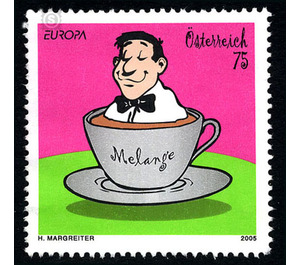CEPT - Austria / II. Republic of Austria 2005 - 75 Euro Cent
Theme: Art & Culture
| Country | Austria / II. Republic of Austria |
| Issue Date | 2005 |
| Face Value | 75.00 |
| Edition Issued | 700,000 |
| Printing Type | Photogravure |
| Stamp Type | Commemorative |
| Item Type | Stamp |
| Chronological Issue Number | 1876 |
| Chronological Chapter | OOS-OE2 |
| SID | 110308 |
| In 51 Wishlists | |
Austria and the coffee house - one thing is hard to imagine without the other. The origin of the Viennese coffee house has become a legend: in 1683 the Turks left sacks of green beans at the gates of Vienna (and pastries in the shape of the crescent, the "Kipferl") and Kolschitzky should have been the one who secured the coffee bags and was the first Viennese to open a coffee house in the house "Zur Blauen Flasche". He became a coffee boiler and had only moderate success. But then one day he mixed sugar and milk into the bitter brew and the Viennese mélange was born. The fact is that in 1714 there were already 11 licensed coffee houses in Vienna. Already in the middle of the 18th century. He read newspapers, played cards and, of course, drank the obligatory glass of water to his coffee. In the Josefi period, the coffee house became more and more popular not only in the city center but also in the suburbs. It should have been the elegant Café Taroni, in which the Schanigarten was invented. "Shani, leave the garden!" According to tradition, the command was to Piccolo Johann to set up outdoor tables in fair weather. The next bloom was during the Viennese congress. Mid-19th century The concert cafés had their peak, Lanner, Strauss and Ziehrer played for the dance and the Viennese came in droves. The Vienna World's Fair in 1873 spread the reputation of the Viennese coffee house in the world. The intellectuals and artists of Vienna traditionally did not meet at home, but in the café. It is said that even the postmen of that time automatically brought the mail for the literati and artists instead of the address in the corresponding cafe. Anton Kuh, Alfred Polgar, Egon Friedell and also the passionate chess player Leonid Trotzky frequented the literary cafés such as Griensteidl or Central, and the artists met in the Café Sperl. The legendary saying of Peter Altenberg is indicative of this era: "Not at home and yet not in the fresh air ..." - his regulars café was incidentally the "Central", which he also stated as his postal address. The passion for the coffee was so strong that in the "Herrenhof" there was even a painter's paint board with 20 different brown shades of color and the guests each ordered the coffee according to the desired color. In times of war, obedience was used to make coffee substitutes (chicory, figs, rye, barley or plum kernels), but the cafe could not be killed. It is and remains an institution, a piece of Austria.


